Detroit, MI Pollen and Allergy Report for Summer 2023
Pollen Allergy Trends in Detroit, MI
When is pollen lowest in Detroit, MI?

February
Lowest month total PPM
Avg. PPM
When is pollen highest in Detroit, MI?

April
Highest month total PPM
Avg. PPM
How does pollen in Detroit, MI compare to Michigan?
Detroit has a lower average PPM than the state of Michigan.
Detroit yearly avg PPM:
Michigan yearly avg PPM:
How does pollen in Detroit, MI compare to the USA?
Detroit has a lower average PPM than the USA.
Detroit yearly avg PPM:
USA yearly avg PPM:
Is pollen worse this year in Detroit, MI?
Spring 2023 was worse than spring 2022.
Spring 2023 PPM:
Spring 2022 PPM:
Average PPM in Detroit, MI


Detroit, MI Pollen and Allergy Breakdown by Month
Grass
When is grass pollen highest in Detroit, MI?
April has the highest grass pollen in Detroit, MI with an average PPM of
When is grass pollen lowest in Detroit, MI?
November has the lowest grass pollen in Detroit, MI with an average PPM of
Tree
When is tree pollen highest in Detroit, MI?
April has the highest tree pollen in Detroit, MI with an average PPM of
When is tree pollen lowest in Detroit, MI?
September has the lowest tree pollen in Detroit, MI with an average PPM of
Weed
When is weed pollen highest in Detroit, MI?
April has the highest weed pollen in Detroit, MI with an average PPM of
When is weed pollen lowest in Detroit, MI?
February has the lowest weed pollen in Detroit, MI with an average PPM of
Detroit, MI Pollen Monthly Breakdown by Pollen Type

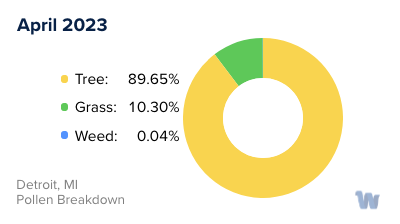





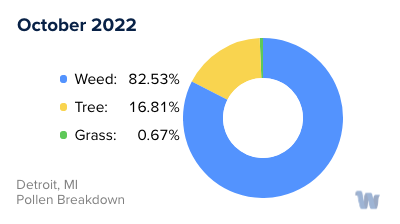
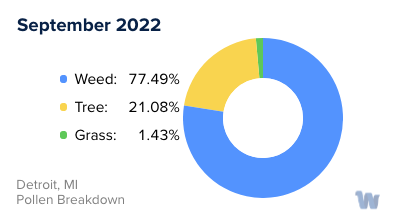
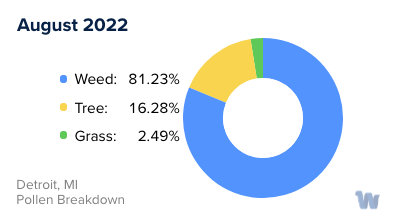

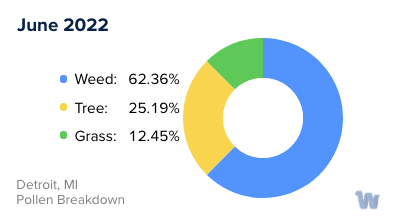
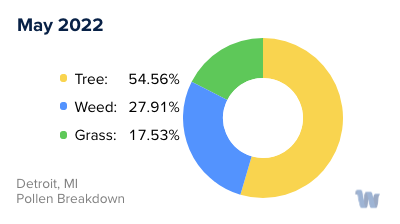

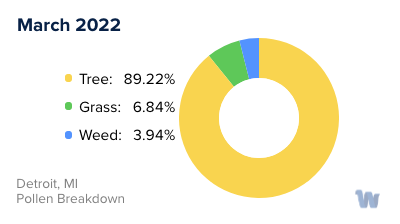

Pollen and Hay Fever in Detroit, MI
In the vibrant city of Detroit, Michigan, the changing seasons are marked not just by the transformation of the landscape, but also by the shifting types of pollen that fill the air. For those susceptible, these microscopic particles can trigger a condition known as hay fever, or in medical parlance, seasonal allergic rhinitis.
As winter recedes, trees are often the first to release their pollen, heralding the start of the allergy season. In Detroit, oak, maple, and pine trees are common culprits, typically starting their pollen production as early as March. The tree pollen season can extend into May, coloring these spring months with a tinge of discomfort for allergy sufferers.
Next comes the grass pollen season. By late spring and early summer, the city's abundant grasses, including timothy, ryegrass, and Kentucky bluegrass, begin their own cycle of pollen release. The peak of this season usually falls in June, turning leisurely picnics in the park into a bit of a sneeze fest for some.
While the summer sun shines brightly, it's also the time when weed pollen comes to the fore. From July to September, plants such as ragweed, plantain, and nettle cast their pollen to the wind. Ragweed, in particular, is a potent allergen and is widespread in Detroit, making late summer and early fall a challenging period for those sensitive to its pollen.
As the colors of fall paint the city, the pollen counts start to dwindle, bringing a much-needed respite to those with hay fever. However, the types of pollen present in the air and their levels can vary from year to year, influenced by factors such as temperature, rainfall, and wind patterns. Therefore, those susceptible to pollen allergies must stay vigilant and be prepared to adapt their lifestyle according to the ebb and flow of the pollen seasons.
In Detroit, understanding the pollen cycles and being aware of which plants trigger your symptoms can help you navigate the city and its seasons with greater ease. But remember, this city's charm and vibrancy are worth the occasional sneeze!.

